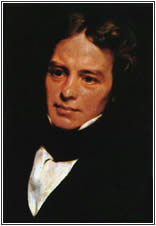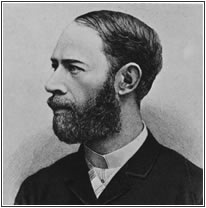
You are here: Home >> History of Light >> The two natures >> The E/M field

In the decades 1860-1870 the Scottish physicist J. C. Maxwell proved that the existence of those waves results electric and magnetic fields. Maxwell proposed that electromagnetic radiation, that it had forecasted, should be followed from weak electric and magnetic fields. To do so he had to develop an idea of a British physicist Michael Faraday.
Faraday explained that electric and magnetic effects result from lines of force that surround conductors and magnets. The previous mentioned fields act the same way that an aquatic wave acts. Maxwell's theory suggested that electromagnetic waves could be generated in a laboratory, a possibility first demonstrated by Heinrich Hertz in 1887, and eight years after Maxwell's death.
 Maxwell could explain all known effects of electromagnetism by considering how the motion of the whirlpools, or vortices, and cells could produce magnetic and electric effects. He showed that the lines of force behave like the structures in the hypothetical fluid.
Maxwell could explain all known effects of electromagnetism by considering how the motion of the whirlpools, or vortices, and cells could produce magnetic and electric effects. He showed that the lines of force behave like the structures in the hypothetical fluid.
Maxwell went further, considering what would happen if the fluid could change density, or be elastic. The movement of a charge would set up a disturbance in an elastic medium, forming waves that would move through the medium.
He considered that light must consist of electromagnetic waves but first needed to prove this by developing a mathematical system. He achieved this in "A Dynamical Theory of the Electromagnetic Field" (1864), in which he developed the fundamental equations that describe the electromagnetic field.  These equations showed that light is propagated in two waves, one magnetic and the other electric, which vibrate perpendicular to each other and perpendicular to the direction in which they are moving (like a wave travelling along a string).
These equations showed that light is propagated in two waves, one magnetic and the other electric, which vibrate perpendicular to each other and perpendicular to the direction in which they are moving (like a wave travelling along a string).
Between 1885 and 1889, Professor H. Hertz produced electromagnetic waves in the laboratory and measured their length and velocity. He showed that the nature of their vibration and their susceptibility to reflection and refraction were the same as those of light and heat waves. As a result he established beyond any doubt that light and heat are electromagnetic radiations.
At last, the wave theory had been completed. In the end of the 19th century, only an idiot or a genius could propose that light is a particle. This genius meant to be A. Einstein, but before we study his work we should not forget to take a look at some other important concepts about light.
Related links (external pages)